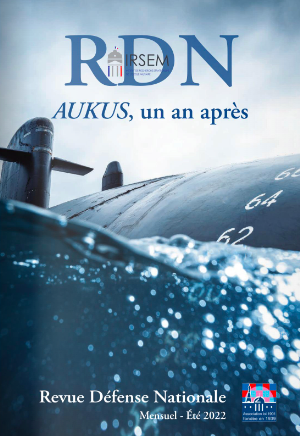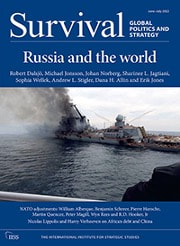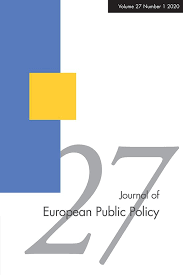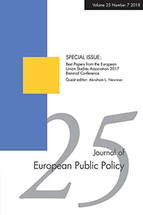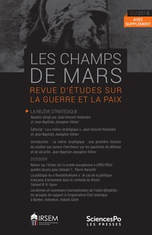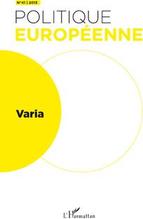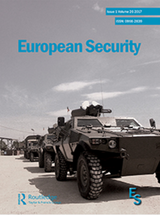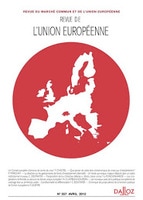ARTICLES
|
"Geoeconomic Power Europe: When Global Power Competition Drives EU Integration", JCMS: Journal of Common Market Studies, 62 (4), 2024, pp. 938–954.
The European Union's (EU's) ‘geoeconomic turn’ denotes the growing integration of international security considerations into EU economic policies. This article introduces the concept of ‘geoeconomic power Europe’ to show how this development has the potential to renew debates on the nature of EU power. Most existing conceptualisations of EU power – whether characterised as civilian, normative, market based, regulatory or liberal – tend to focus on the EU's endogenous characteristics. However, the added value of the concept of geoeconomic power is that it redirects attention to the ‘co-constitution’ loop between global power competition and the evolution of EU power. In this article, I present an analytical framework that highlights the drivers of EU geoeconomic power and distinguishes between systemic pressures, the intra-EU policy process and the impact on EU power. I conclude that the concept of geoeconomic power Europe can help to bridge theories of international security and economic interdependence, particularly neorealism and neofunctionalism. |
|
"A ‘Geopolitical Commission’: Supranationalism Meets Global Power Competition", JCMS: Journal of Common Market Studies, 61 (4), 2023, pp. 970–987.
This article examines the origins and operationalisation of the concept of a ‘geopolitical Commission’, which has been promoted by President of the European Commission Ursula von der Leyen since 2019. This concept has been used to guide the stronger co-ordination of the external aspects of the Commission's work. It is also symptomatic of the growing role of strategic considerations in the Commission's recent initiatives, particularly through the objective of strengthening the EU's ‘open strategic autonomy’. To explain this phenomenon, I combine three different theoretical perspectives: neorealism, neofunctionalism, and geoeconomics. I conclude that the geopolitical Commission should be understood as the result of the interactions between exogenous factors – the intensification of global power competition and the rise of geoeconomic strategies – and endogenous factors, such as the rivalry between the Commission and the European External Action Service and the functional link between the Commission's economic powers and international security issues. |
|
"Un monde, deux théâtres : dilemmes et ricochets entre Europe et Indopacifique" (One world, two theatres: dilemmas and ricochet effects between Europe and the Indopacific), Revue Défense Nationale, Summer 2022, pp. 19–24.
|
|
With Martin Quencez, “NATO facing China: responses and adaptations”, Survival, 64 (3), 2022, pp. 73–86.
This article explores and assesses NATO’s various options for dealing with Chinese power. First, in terms of military approaches, we argue that NATO is unlikely to play a substantial role in US-led efforts to balance China in the Indo-Pacific or to designate China as a “threat” in the North Atlantic area. Because a logic of a clear-cut geographic division of labour between the United States and European partners would weaken the Alliance’s cohesion, NATO should instead focus on better integrating the “China factor” into its military planning in anticipation of the potential knock-on effects of a crisis in Asia on the European theatre. Second, in terms of political approaches, although a formal expansion of NATO’s competencies is unlikely, stronger coordination with Indo-Pacific actors and with the European Commission could help overcome many of the Alliance’s geographic and functional limitations in dealing with China. |
|
"Supranationalism strikes back: a neofunctionalist account of the European Defence Fund", Journal of European Public Policy, 27 (6), 2020, pp. 853–872.
In June 2017, the European Commission launched a proposal for a European Defence Fund (EDF) aimed at financing transnational defence research and development through the European Union (EU) budget. This initiative has been described as a ‘game changer’ for European defence cooperation. I argue that the EDF can be analysed through the lens of neofunctionalist theory and challenges the hypotheses of new intergovernmentalism on the evolution of EU governance. The EDF is also marked by some innovative features, largely because it concerns a policy area – defence – in which supranational dynamics were traditionally limited. First, the Commission displayed an increasingly political cultivated spillover by its promotion of the EDF. Second, the EDF illustrates a new type of offensive functional spillover from the economy to defence. Third, the implementation of the EDF has launched a bureaucratic spillover that could lead to further initiatives. |
|
"The inter-parliamentary alliance: how national parliaments empowered the European Parliament", Journal of European Public Policy, 25 (7): Best Papers from the European Union Studies Association 2017 Biennial Conference, 2018, pp. 1010–1028.
National parliaments (NPs) have been generally considered the ‘victims’ of European integration – at least until the 1990s. In this article, I argue instead that NPs played an active and decisive role in shaping European institutions since the 1960s. In particular, NPs were the key actors driving the empowerment of the European Parliament (EP). When national governments decided to transfer some of their powers to the European level, many NPs threatened to oppose those reforms unless governments agreed to increase the EP’s powers. These NPs considered the EP’s empowerment to be effective compensation for their own lost powers. Two case studies were selected to illustrate this argument: the first transfer of budgetary powers to the EP (1970) and the first transfer of legislative powers through the Single European Act (1986). In both cases, the EP’s empowerment was made possible by an inter-parliamentary alliance between the EP and NPs. |
|
"Retour sur l'échec de l'« armée européenne » (1950-1954) : quelles leçons pour demain ?" (The failure of the 'European Army' (1950-1954): lessons for tomorrow), Les Champs de Mars, 30, 2018, pp. 47–72.
At a time when we are witnessing the renewal of European defence cooperation, and with the prospect of a “European army” having been raised by several European and national leaders, this article revisits the initial attempt to integrate national armies under European command, through the European Defence Community (EDC). We will particularly focus on the reasons for the failure of this first European army project. In contrast to explanations that focus on the ideological and parliamentary dimension of the debate, I will look specifically at France's military constraints in order to understand how a project that was considered viable in 1950, came to be seen as unfeasible just a few years later. I will rely on the concept of the geostrategic dilemma to show that the competition between an Eastern front on the one hand (marked by the Soviet threat) and a Southern front on the other (marked by colonial crises in Indochina and North Africa) is at the heart of the evolution of the French position on the EDC. Finally, I will show that the European Union is also suffering from a geostrategic dilemma between territorial defence on the Eastern flank and crisis management in the South, particularly since the 2014 Ukrainian crisis. Although this geostrategic dilemma is a major hindrance for European defence integration, we will see that it could be resolved by institutionalised transactions between states with different priorities, which would also contribute to the development of a European strategic culture. |
|
"Transposer la Cinquième République : le régime politique national comme source de la politique européenne de la France" (Transposing the Fifth Republic: the national political regime as a source of France’s European policy), Politique européenne, 55, 2017, pp. 116–141.
This article contends that the logic of the regime of the Fifth Republic influenced France’s European policy, especially towards the European Parliament. This argument is illustrated by two case studies: the 1965 Empty Chair crisis and the 1986 Single European Act. In both cases, France’s position was defined by the executive, which sought to transpose to the European level its practice of subordinating the French Parliament, giving Council powers priority over those of the European Parliament. |
|
"Interdependence, asymmetric crises, and European defence cooperation", European Security, 26 (2), 2017, pp. 226–252.
Although international crises are often believed to represent windows of opportunity to strengthen European defence cooperation, recent crises have not seemed to produce a clear convergence of European Union (EU) member states’ security interests. This article seeks to address this puzzle by arguing that European defence cooperation is a response to crises that place European states in a situation of military interdependence. Conversely, asymmetric crises, i.e. crises that affect European states unevenly, encourage those states to maintain their autonomy of action. This theoretical argument is supported by two case studies: the failure of the European Defence Community in the early 1950s and the current difficulties experienced by the EU’s military operations. These two cases illustrate a striking continuity in that, because of (neo)colonial ties in particular, European states are often unevenly affected by international crises, which tends to make defence cooperation less effective. |
|
"Le Président du Conseil européen : histoire d’un mythe constitutionnel" (The President of the European Council: story of a constitutional myth), Revue du Marché commun et de l’Union européenne, 538, 2010, pp. 277–285.
This article shows that before its establishment, the function of President of the European Council had been defined in two very different ways. One the one hand, it was first conceived as a consensus’ facilitator, able to strengthen the influence of larger member states. However, on the other hand, the context of the 2005 referendums favoured its promotion in public debates as a charismatic political leader. That presidential myth explains the deception met by the election of Herman Van Rompuy in 2009. The article concludes that contradictory constraints are responsible for the tension between how European institutions work and how they would like to be seen by citizens. |


